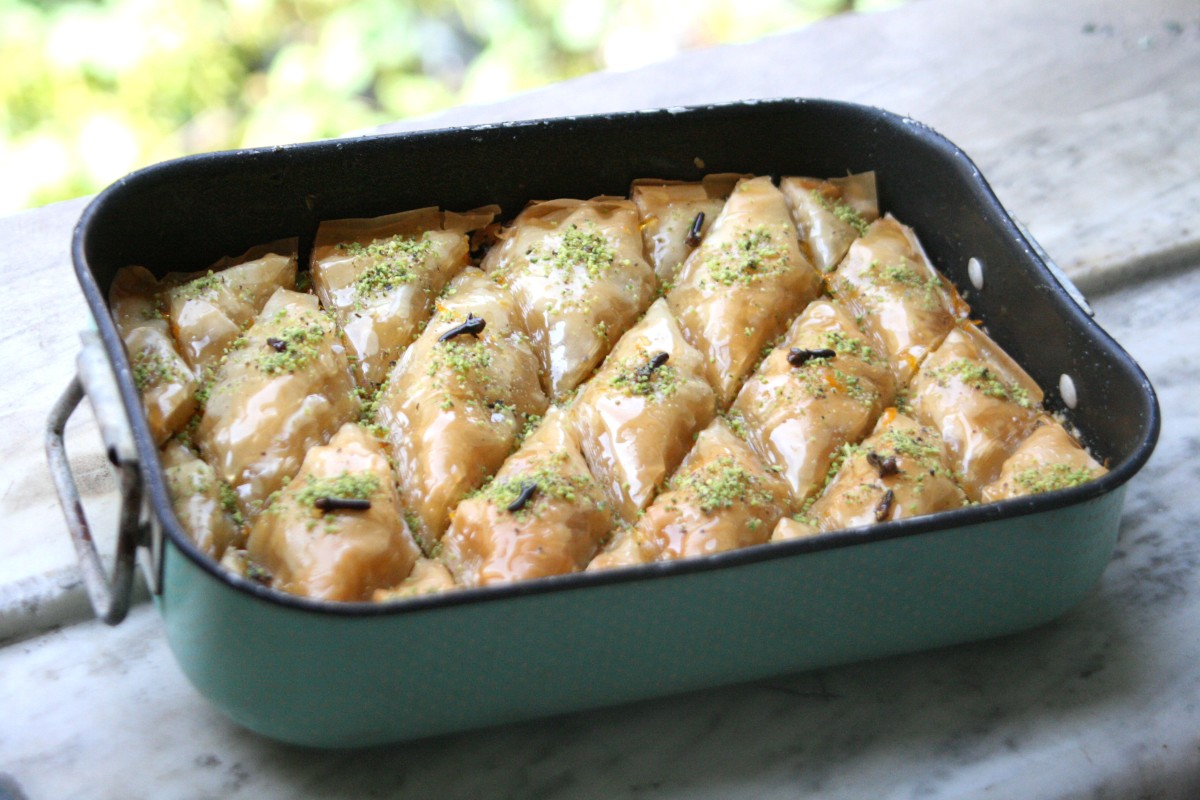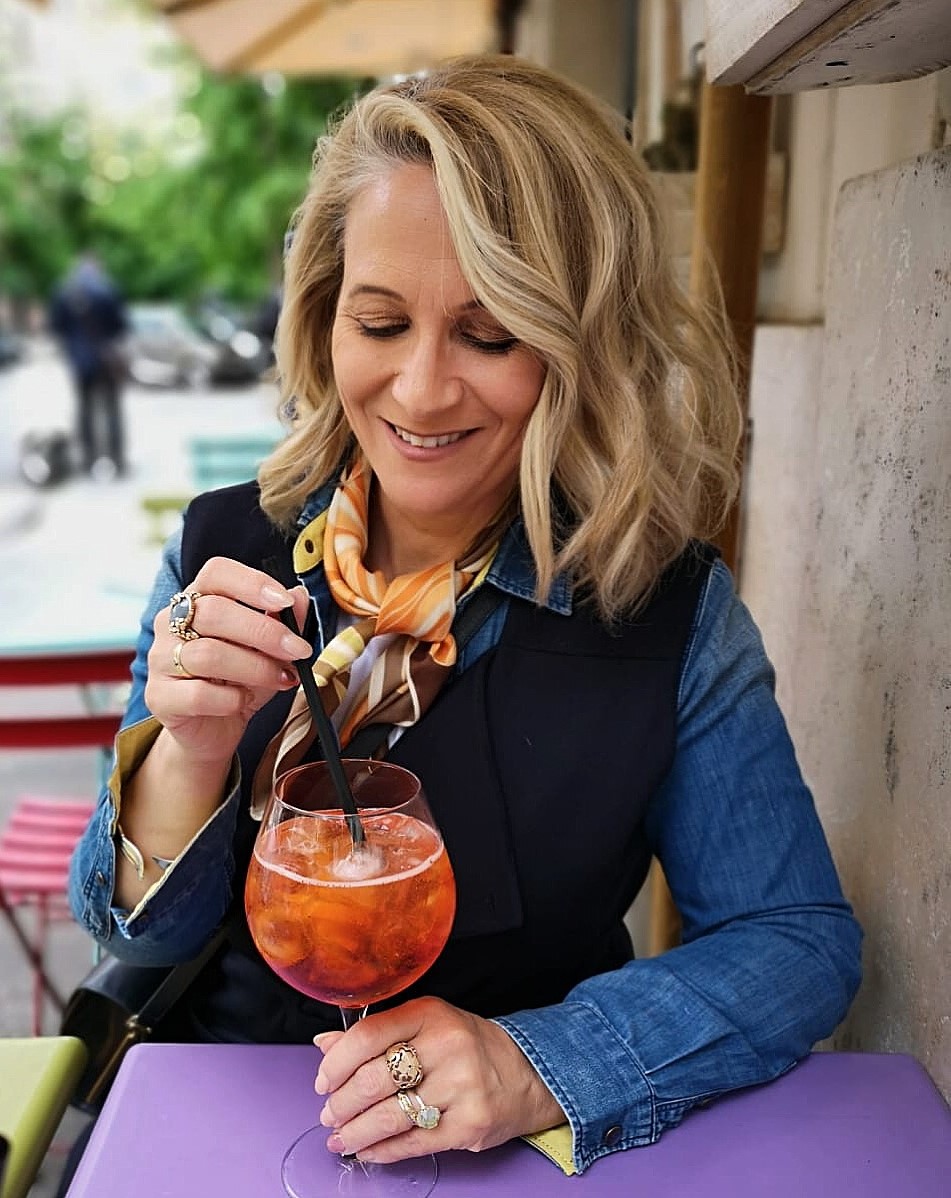When I lived in an apartment as a student in North Melbourne, I remember buying Baklava from the Victoria Market. Although sickly sweet, I adore it and love the fine, delicate layers of filo pastry that are an integral part of this dessert. The origins of Baklava are a bit confusing, with the Greeks and Turks both claiming it as their own. It is characteristic of food from the former Ottoman Empire. Suffice to say, the history of Baklava is as diverse as the number of ways it can be prepared and the types of nuts and syrup used often give you an idea as to the recipe’s origins. My friend Anna said it perfectly when she said. “We are all connected in one way or another”.
I will be honest, I read a few recipes, and in the end combined two. I altered some measurements, and improvised when I was too lazy to go back to the supermarket. I am really proud of how it turned out though, as it’s the first time I’ve ever tried to make it.

Baklava
- 80g walnuts
- 80g blanched whole almonds
- 80g pistachio nuts
- 80g unsalted peanuts (I added these when I realised I was a bit under weight with the nuts. Original recipe calls for 100g each of walnuts, almonds & Pistachio nuts).
- 1/4 teaspoon ground cloves
- 125ml honey
- 200g sugar
- 60ml lemon juice
- 1/2 teaspoon cinnamon
- 9 whole cloves
- zest of one orange
- 180ml water
- 150g butter, melted
- 2 packets store bought Filo Pastry.

-
Begin by making the syrup by adding to a saucepan the honey, sugar, lemon juice, cinnamon, whole cloves, orange zest and water. Bring to a boil, and then allow to simmer for about 15 minutes. (The syrup will reduce). Leave to cool. (The syrup must be cool when it is poured over the baklava otherwise the pastry will go soggy.)
-
In a food processor, whiz all nuts until finely chopped.
- Add nuts to a bowl, add ground cloves and mix well.
- Preheat oven to 160°C , fan forced.
- Brush the sides and base of a small baking tin (mine was about 18cm x 24cm) with the melted butter. Open Filo Pastry and using the baking tray as a guide, cut around the Filo so that it will be the same size as the baking tray. Use a sharp knife! Cover the Filo with a clean damp tea towel to prevent the pastry drying out.
- Work with 1 filo sheet at a time, and brush one side with butter, then place in the baking tray. Repeat to create 9 layers. Scatter half of the nut mixture on top.
- Repeat layering 6 buttered Filo pastry sheets on top of the nuts. Scatter the remaining nuts on top, and continue with the buttered Filo Pastry sheets again. I sort of lost count here, but I think I added another 9 layers. Brush the top generously with butter and place tray in the freezer for 10 minutes.
- Using a sharp knife, cut the Baclava into diamonds, ensuring your knife goes right down to the bottom of the baking tray.
- Place in oven, and bake for 35 minutes or until pastry is golden.
-
Remove the baklava from the oven and carefully pour half the cooled syrup over the top. Leave for 5 minutes, then pour over the remaining syrup. Decorate by sprinkling with ground pistachio nuts. Allow the baklava to cool before removing the pieces from the pan with a knife. You might need to use the knife again just to ensure that each piece is sliced and separated well. Baklava can be kept in the tray and taken out for serving. Covered in a cool, dry place, it will keep for up to a week……….If it lasts that long!

BAKLAVA
- 80g di noci
- 80g di mandorle intere
- 80g di pistacchi
- 80g di arachidi non salate (le ho aggiunte quando ho capito che ero un po’ sotto peso con le noci. La ricetta originale richiede 100g di noci, mandorle e noci di pistacchi).
- 1/4 di cucchiaino di chiodi di garofano macinati
- 125ml di miele
- 200g zucchero
- 60ml di succo di limone
- 1/2 cucchiaino di cannella
- 9 chiodi di garofano
- scorza di arancio
- 180 ml di acqua
- 50g di burro, fuso
- 2 pacchetti di pasta Fillo
- Iniziare facendo lo sciroppo ponendo in una pentola il miele, lo zucchero, il succo di limone, la cannella, tutti i chiodi di garofano, la scorza di arancia e l’acqua. Portare a bollire e poi lasciarlo sobbollire per circa 15 minuti. (Lo sciroppo si ridurrà). Lasciare raffreddare. (Lo sciroppo deve essere freddo quando viene versato sopra la baklava altrimenti la pasta filo non sarà croccante).
- In un robot di cucina, trittare tutti le noci finemente.
- Mettere le noci in una ciotola, aggiungere i chiodi di garofano macinati e mescolare bene.
- Preriscaldare il forno a 160 ° C. – forno ventilato.
- Con un pennello per pasticceria, spennellare i lati e la base di una piccola teglia da forno (la mia era circa 18cm x 24cm) con il burro fuso.
- Aprire la pasta Fillo e utilizzando la teglia da forno come una guida, tagliare la pasta fillo in modo che sia della stessa dimensione della teglia di cottura. Utilizzare un coltello affilato! Coprire la pasta fillo con un asciugamano pulito e umido per evitare che la pasta fillo si asciughi.
- Lavorare un foglio di Fillo alla volta e spennellare un lato con burro, quindi collocare nella teglia. Ripeti per creare 9 strati.
- Mettere la metà della miscela di noci sulla superficie.
- Ripetere la stratificazione di 6 strati di pasta Fillo sopra le noci. Aggiungere le noci rimanenti sulla parte superiore e continuare nuovamente con i fogli di pasta fillo, aggiungendo altri 9 strati. Spennellare bene la parte superiore con il burro e posizionare la teglia nel congelatore per 10 minuti.
- Utilizzando un coltello tagliente, tagliare la Baklava in diamanti, assicurandosi che il coltello va giù fino in fondo alla teglia di cottura.
- Mettere in forno e cuocere per 35 minuti o finché la pasta Fillo è dorata.
- Rimuovere la baklava dal forno e versare con cura metà dello sciroppo raffreddato sopra la parte superiore. Lasciare per 5 minuti, quindi versare sopra lo sciroppo rimanente. Decorare la baklava a piacere. Io ho usato i pistacchi macinati.
- Lasciare raffreddare la baklava prima di rimuovere i pezzi dalla teglia con un coltello. Potrebbe essere necessario utilizzare nuovamente il coltello solo per assicurare che ogni pezzo sia tagliato e separato bene.
Baklava può durare fino a una settimana se mantenuta coperta in un luogo fresco e asciutto ………. Se qualcuno non se la mangia prima!



